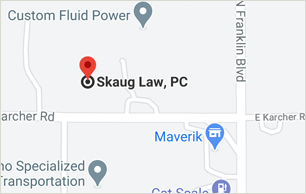Trucking – What is the Difference Between Interstate and Intrastate?
Last updated Thursday, September 19th, 2024

These two major types of trucks are everyday sights in Boise, Idaho. Why does noting differences between interstate and intrastate trucking matter? Truckers need to know so they can follow specific rules.
Passenger vehicle drivers can stay in the loop. Knowing which trucks do what raises awareness. If you’re in an accident with a truck, you’re already ahead of the game when you have the scoop.
Were you involved in a truck accident? Do you have questions about what type of truck was responsible? Schedule a consultation with us! As experienced Boise truck accident attorneys, we know all the little details of truck accident law.
Our experts at Skaug Law can speak with you about your case. We’ll answer your questions. We get high-dollar settlements for truck accident victims all the time. Could you be the next person to benefit from our experience?
What is Interstate vs. Intrastate?
Interstate trucks are driven from one state to the next and country to country. Truck shipments can be transported within one state but the final destination for this cargo lies outside of that state’s borders.
The Federal Motor Carrier Safety Association (FMCSA) oversees interstate trucking rules and regulations. This federal government agency aims to keep interstate travel as safe as possible.
Companies with trucks traveling outside state lines may need:
- Apportioned License Plates
- International Fuel Tax Agreement (IFTA) Registration
- Interstate Trucking Authority
- State-specific Permits
- Unified Carrier Registration (UCR) Registration
Intrastate trucks don’t cross state lines. These commercial motor vehicles may transport goods but only within a designated state. Each state can specify an agency to set regulations.
Every state can set its own trucking requirements. These rules may differ from those of the FMCSA. Examples may include:
-
- Hours of Service
- Insurance Coverage
- Weight Exemptions and Restrictions
Get Your Free Injury Case Review
Examples of Interstate Trucks
All kinds of products hitch a ride on these massive machines. Commercial motor vehicles may deliver lobsters from Maine to Saskatchewan. Or a simple haul and return just over the state line is possible. These trucks can be seen regularly throughout the country.
- Car Carriers. Many passenger vehicles can stack onto these trailers. Cars can be picked up from ports and delivered to dealers.
- Dry Bulk Carriers. While these trailers resemble tankers, they actually transport mass quantities of dry goods like grain or flour.
- Flatbed Trucks. These beauties do more than house parade floats. Trailers have a long, open area. This space allows for strange-shaped or oversized cargo. Wind turbine blades, supersized tires and boats are transported this way.
- Livestock Trailers. Tons of grates or ways for animals to get fresh air makes these trailers easy to recognize. Cattle, sheep, pigs and other livestock can be moved using this method.
- Refrigerated Trailers. Commonly called a “reefer” in trucking lingo, these trailers are insulated. Refrigeration units that keep the entire area cool are located at the front. Perishables like dairy products and frozen foods are hauled in these containers.
- Tankers. These huge soda can-shaped carriers haul many products. Tanks can be refrigerated, pressurized or insulated. Food-grade varieties can transport anything from milk to juice. This type of truck also hauls hazardous materials like gasoline, condensed gases and chemicals. Another use? Toxic waste disposal.
- Tractor-trailers. Every driver is probably familiar with the semi-truck. Big rigs carry many types of cargo such as clothing, household goods, nonperishable food items and farm equipment.
Examples of Intrastate Trucks
These commercial motor vehicles generally operate within a state. Owners must have required documentation. Each state may have its own mandates.
- Cherry Picker Trucks. Utility and cable vehicles like these may have a bucket. This work platform is hydraulically lifted to raise people higher.
- Delivery Trucks. UPS, Amazon and FedEx logos may be seen on these vehicles that distribute packages.
- Dump Trucks. Often spotted around building sites, these trucks don’t come to play. Dirt and debris can be hauled off. The back-end lifts to dump collected material.
- Garbage Trucks. While there are many varieties, the basic purpose is the same – to gather and haul away trash.
- Moving Trucks. These vehicles can be rented or owned by moving companies for completing household moves within the same state.
- Ready-mix Concrete Trucks. Concrete is churned around in the big egg shape, called the rotating mixer. Trucks can both deliver and stir the concrete.
- Tow Trucks. These trucks assist wrecked or broken-down motor vehicles. Most regular-sized trucks can pick up vehicles within a state’s borders.
How Are Interstate and Intrastate Similar?
These two terms differ widely in the world of trucking. However, similarities exist. Some things never change – regardless of travel plans. Although different for interstate and intrastate, mandates must be addressed for:
- Alcohol and Drug Testing. The FMCSA has specific testing standards. However, just because a trucker doesn’t leave state borders doesn’t mean he’s off the hook. The Department of Transportation (DOT) requires drivers of certain trucks to be tested too.
- Insurance. The FMCSA sets the amount of liability insurance that interstate commercial motor vehicles must carry. This dollar amount increases when transporting hazardous materials or people. Intrastate insurance premiums vary from state to state. Most coverage requirements depend on type and size of freight.
- Licensing. A Commercial Driver’s License is required. Proper endorsements may be necessary.
One more thing these two kinds of trucks share is the potential for danger. While there are safety strategies in place, accidents continue to happen.
If you’ve been injured in a big rig crash, there’s no time to lose! Schedule a no-risk meeting with our truck accident law firm today! We’ll go over your case. If you’re entitled to compensation, we can and will help YOU!

